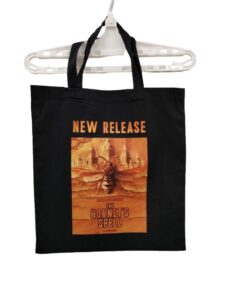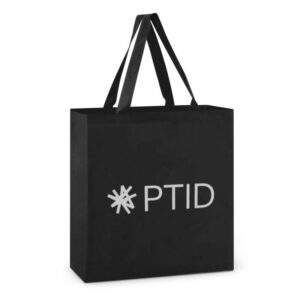Home » Promotional Bags Hub: Expert Tips, Case Studies & Buying Guide »
Customised Bag Trends 2025: What’s In and What’s Out
Last Updated:24 July 2025
Custom-branded bags are a powerful tool for organisations aiming to maximise their visibility. This year, changing consumer priorities and technological progress are reshaping the expectations for promotional merchandise. Businesses must remain vigilant, adapting to these shifts to ensure their campaigns resonate with their intended audiences. This article delves into the defining trends for customised bags in 2025, spotlighting those set to captivate and those likely to fade from relevance. Let us consider the forces steering this dynamic field.
How Effective Are Custom-Branded Bags

Black tote bag
Personalised bags offer a remarkable opportunity to extend brand reach. They slip easily into recipients’ daily lives, carrying logos through markets, workplaces, and public spaces. Every use broadcasts an organisation’s identity without additional expense. Yet, their effectiveness depends on meeting modern design, function, and values standards. In 2025, astute organisations will embrace sustainability, creativity, and practicality to leave a lasting impression. Knowing which paths to follow—and which to avoid—proves essential for success.
Eco-Friendly Materials Lead the Way
Sustainability stands at the forefront of promotional trends for 2025. Recycled cotton, organic hemp, and biodegradable composites, particularly in tote bags, are gaining widespread approval. These choices lessen ecological harm while showcasing a brand’s dedication to a greener future. Organisations that adopt such materials earn trust and admiration from eco-minded recipients. On the flip side, bags crafted from virgin plastics or non-recyclable fabrics are losing ground. People view them as wasteful, which damages a brand’s reputation. Flimsy, disposable designs that wear out quickly face outright dismissal as users seek items built to last. In 2025, committing to sustainability isn’t optional—staying relevant is necessary.
Personal Touches Build Bonds
Personalisation is carving out a strong place in 2025, creating meaningful links between brands and users. Custom embroidery, monogrammed initials, or choose-your-own colour options let organisations offer bags that feel special. Backpacks with adjustable straps or totes with tailored prints hit the mark at corporate gatherings or reward programs. This approach turns giveaways into cherished items, deepening brand loyalty.
Plain, cookie-cutter bags spark little excitement. Users see them as generic, reducing their urge to keep or carry them. Yet, overly intricate personalisation can overwhelm businesses with high costs or logistical snags. Finding a sweet spot—unique enough to matter, simple enough to scale—makes all the difference.
Colours That Speak Volumes
Colour choices play a significant role in 2025’s promotional bag trends. Natural tones like sage, rust, and slate lead tying into eco-friendly vibes. These shades pair well with sustainable fabrics, reinforcing a brand’s green credentials. A few vivid accents—think ochre or rich navy—bring energy without stealing the show. Tote bags use these hues for standout logos, while backpacks lean on them for subtle flair.
Bright neons or clashing colours feel out of step now. They jar against today’s taste for restraint, pushing away those who value sophistication. Dull, single-tone bags also struggle, fading into the crowd. Organisations need colours that strike a balance—bold enough to notice and refined enough to fit the brand’s story.
Built to Last, Built to Impress

Black backpack
Sturdiness remains non-negotiable for promotional bags. Users expect gear that holds up under daily strain, keeping brands visible for longer. Strong stitching, reliable zippers, and tough materials like recycled polyester or natural canvas set the bar for 2025’s best bags. Backpacks with comfy straps and totes with solid handles build trust, inviting constant use. Cheap bags that split or fray fast get tossed aside. They fail to deliver and cast a shadow on a brand’s quality.
Tapping Into Local Flavour
Regional and cultural influences are shaping bag trends more than ever. In Australia, coastal communities gravitate toward light, water-resistant totes perfect for beach trips or market runs. City hubs call for backpacks with tech-friendly pockets to match hectic commutes. Brands that weave in local touches—like Indigenous designs or colours inspired by the landscape—build stronger ties with their audience.
Generic bags that ignore these nuances feel flat. They miss the mark on local needs or values, ending up unused. However, designs that go to niche might not travel well beyond their region. In 2025, balancing local pride and broad appeal lifts a campaign’s impact.
Small and Nimble Takes Over

Tote bag
Smaller, lighter bags are climbing in demand as people seek convenience. Totes that fold into a pocket or compact backpacks with slim profiles suit urbanites and travellers on the move. These keep function high while cutting bulk, fitting neatly into packed schedules. Brands gain from their portability as users take them everywhere.
Big, heavy bags are losing their grip. They’re awkward in tight spaces, discouraging regular use. Fabrics that look good but weigh too much also fall short. The 2025 benchmark blends lightweight with a rugged build, meeting calls for ease and strength.
What’s Falling Behind
Some approaches won’t cut it in 2025. Throwaway bags handed out in bulk at events are fading fast—they harm the environment and vanish quickly from use. Bags overloaded with logos come off as try-hard, lacking the confidence of subtle branding. Less is often more.
Fussy designs with pointless features also fail. Backpacks with too many pockets or totes with extra straps annoy users, cutting engagement. Trends chasing short-lived buzz—like shiny metallics or odd shapes—burn out fast, missing the staying power needed for real impact. Businesses must sidestep these traps to keep sharp.
Making Trends Work
Organisations should first clarify their goals to harness these shifts—wide exposure pairs well with green totes at public events. Focused loyalty calls for tech-smart backpacks for select groups. Tight budgets mean choosing lasting quality over sheer numbers.
Know your audience well. Younger folks love custom details and tech perks, while older users lean toward simple, green designs. Local tastes shape fabric and colour picks, rooting the campaign in place. Small test runs reveal what clicks, letting brands fine-tune their approach.
Teaming up with ethical suppliers strengthens credibility. Working with local creators for unique designs adds depth. Tracking how bags are used—through feedback or spotting them in action—shows what’s working. A clear plan ties it all to 2025’s pulse.





